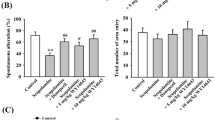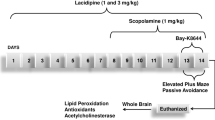Abstract
Memory impairment is the most common symptom in patients with Alzheimer’s disease. The purpose of this study is to evaluate the memory enhancing effects of P7C3, a recently identified compound with robust proneurogenic and neuroprotective effects, on the cognitive impairment induced by scopolamine, a muscarinic acetylcholine receptor antagonist. Different behavior tests including the Y-maze, Morris water maze, and passive avoidance tests were performed to measure cognitive functions. Scopolamine significantly decreased the spontaneous alternation and step-through latency of C57BL/6J mice in Y-maze test and passive avoidance test, whereas increased the time of mice spent to find the hidden platform in Morris water maze test. Importantly, intraperitoneal administration of P7C3 effectively reversed those Scopolamine-induced cognitive impairments in C57BL/6J mice. Furthermore, P7C3 treatment significantly enhanced the level of brain-derived neurotrophic factor (BDNF) signaling pathway in the cortex and hippocampus, and the usage of selective BDNF signaling inhibitor fully blocked the anti-amnesic effects of P7C3. Therefore, these findings suggest that P7C3 could improve the scopolamine-induced learning and memory impairment possibly through activation of BDNF signaling pathway, thereby exhibiting a cognition-enhancing potential.






Similar content being viewed by others
Abbreviations
- AchE:
-
Acetyl-cholinesterase
- AD:
-
Alzheimer’s disease
- ANOVA:
-
Analysis of variance
- BDNF:
-
Brain derived neurotrophic factor
- CREB:
-
cAMP response element-binding protein
- GAPDH:
-
Glyceraldehydes-3-phosphate dehydrogenase
- NAD+ :
-
Nicotinamide adenine dinucleotide
- NAMPT:
-
Nicotinamide phosphoribosyltransferase
- TrkB:
-
Tyrosine kinase B
- PD:
-
Parkinson disease
References
Schonberger SJ, Edgar PF, Kydd R, Faull RL, Cooper GJ (2001) Proteomic analysis of the brain in Alzheimer’s disease: molecular phenotype of a complex disease process. Proteomics 1:1519–1528
Brookmeyer R, Johnson E, Ziegler-Graham K, Arrighi HM (2007) Forecasting the global burden of Alzheimer’s disease. Alzheimers Dement 3:186–191
Karran E, Mercken M, De Strooper B (2011) The amyloid cascade hypothesis for Alzheimer’s disease: an appraisal for the development of therapeutics. Nat Rev Drug Discov 10:698–712
Coyle JT, Price DL, DeLong MR (1983) Alzheimer’s disease: a disorder of cortical cholinergic innervation. Science 219:1184–1190
Sugimoto H, Yamanishi Y, Iimura Y, Kawakami Y (2000) Donepezil hydrochloride (E2020) and other acetylcholinesterase inhibitors. Curr Med Chem 7:303–339
Schliebs R, Arendt T (2011) The cholinergic system in aging and neuronal degeneration. Behav Brain Res 221:555–563
Ahmed T, Gilani AH (2009) Inhibitory effect of curcuminoids on acetylcholinesterase activity and attenuation of scopolamine-induced amnesia may explain medicinal use of turmeric in Alzheimer’s disease. Pharmacol Biochem Behav 91:554–559
Parsons CG, Danysz W, Dekundy A, Pulte I (2013) Memantine and cholinesterase inhibitors: complementary mechanisms in the treatment of Alzheimer’s disease. Neurotox Res 24:358–369
Casey DA, Antimisiaris D, O’Brien J (2010) Drugs for Alzheimer’s disease: are they effective? PT 35:208–211
Alonso M, Bekinschetin P, Cammarota M, Vianna MR, Izquierdo I, Medina H (2005) Endogenous BDNF is required for long-term memory formation in the rat parietal cortex. Learn Mem 12:504–510
Bekinschtein P, Cammarota M, Katche C, Slipczuk L, Rossato JI, Goldin A et al (2008) BDNF is essential to promote persistence of long-term memory storage. Proc Natl Acad Sci USA 105:2711–2716
Shaywitz AJ, Greenberg ME (1999) CREB: a stimulus-induced transcription factor activated by a diverse array of extracellular signals. Annu Rev Biochem 68:821–861
Alberini CM (2009) Transcription factors in long-term memory and synaptic plasticity. Physiol Rev 89:121–145
Chen G, Zou X, Watanabe H, van Deursen JM, Shen J (2010) CREB binding protein is required for both short-term and long-term memory formation. J Neurosci 30:13066–13077
Dworkin S, Mantamadiotis T (2010) Targeting CREB signalling in neurogenesis. Expert Opin Ther Targets 14:869–879
Saura CA, Valero J (2011) The role of CREB signaling in Alzheimer’s disease and other cognitive disorders. Rev Neurosci 22:153–169
Pieper AA, Xie S, Capota E, Estill SJ, Zhong J, Long JM et al (2010) Discovery of a proneurogenic, neuroprotective chemical. Cell 142:39–51
Gould E, Beylin A, Tanapat P, Reeves A, Shors TJ (1999) Learning enhances adult neurogenesis in the hippocampal formation. Nat Neurosci 2:260–265
Snyder JS, Hong NS, McDonald RJ, Wojtowicz JM (2005) A role for adult neurogenesis in spatial long-term memory. Neuroscience 130:843–852
De Jesus-Cortes H, Xu P, Drawbridge J, Estill SJ, Huntington P, Tran S et al (2012) Neuroprotective efficacy of aminopropyl carbazoles in a mouse model of Parkinson disease. Proc Natl Acad Sci USA 109:17010–17015
Tesla R, Wolf HP, Xu P, Drawbridge J, Estill SJ, Huntington P et al (2012) Neuroprotective efficacy of aminopropyl carbazoles in a mouse model of amyotrophic lateral sclerosis. Proc Natl Acad Sci USA 109:17016–17021
Blaya MO, Bramlett HM, Naidoo J, Pieper AA, Dietrich WD (2014) Neuroprotective efficacy of a proneurogenic compound after traumatic brain injury. J Neurotrauma 31:476–486
Sun XL, Ito H, Masuoka T, Kamei C, Hatano T (2007) Effect of Polygala tenuifolia root extract on scopolamine-induced impairment of rat spatial cognition in an eight-arm radial maze task. Biol Pharm Bull 30:1727–1731
Wang Q, Sun LH, Jia W, Liu XM, Dang HX, Mai WL et al (2010) Comparison of ginsenosides Rg1 and Rb1 for their effects on improving scopolamine-induced learning and memory impairment in mice. Phytother Res 24:1748–1754
Oh SR, Kim SJ, Kim DH, Ryu JH, Ahn EM, Jung JW (2013) Angelica keiskei ameliorates scopolamine-induced memory impairments in mice. Biol Pharm Bull 36:82–88
Park SJ, Ahn YJ, Oh SR, Lee Y, Kwon G, Woo H et al (2014) Amyrin attenuates scopolamine-induced cognitive impairment in mice. Biol Pharm Bull 37:1207–1213
Jiang B, Xiong Z, Yang J, Wang W, Wang Y, Hu ZL et al (2012) Antidepressant-like effects of ginsenoside Rg1 are due to activation of the BDNF signalling pathway and neurogenesis in the hippocampus. Br J Pharmacol 166:1872–1887
Tapley P, Lamballe F, Barbacid M (1992) K252a is a selective inhibitor of the tyrosine protein kinase activity of the trk family of oncogenes and neurotrophin receptors. Oncogene 7:371–381
Yan HC, Qu HD, Sun LR, Li SJ, Cao X, Fang YY et al (2010) Fuzi polysaccharide-1 produces antidepressant-like effects in mice. Int J Neuropsychopharmacol 13:623–633
Zhu XH, Yan HC, Zhang J, Qu HD, Qiu XS, Chen L et al (2010) Intermittent hypoxia promotes hippocampal neurogenesis and produces antidepressant-like effects in adult rats. J Neurosci 30:12653–12663
Bullock R (2002) New drugs for Alzheimer’s disease and other dementias. Br J Psychiatry 180:135–139
Deng W, Aimone JB, Gage FH (2010) New neurons and new memories: how does adult hippocampal neurogenesis affect learning and memory? Nat Rev Neurosci 11:339–350
Carter J, Lippa CF (2001) Beta-amyloid, neuronal death and Alzheimer’s disease. Curr Mol Med 1:733–737
Niikura T, Tajima H, Kita Y (2006) Neuronal cell death in Alzheimer’s disease and a neuroprotective factor, humanin. Curr Neuropharmacol 4:139–147
Donev R, Kolev M, Millet B, Thome J (2009) Neuronal death in Alzheimer’s disease and therapeutic opportunities. J Cell Mol Med 13:4329–4348
Yamada K, Mizuno M, Nabeshima T (2002) Role for brain-derived neurotrophic factor in learning and memory. Life Sci 70:735–744
Tongiorgi E, Righi M, Cattaneo A (1997) Activity-dependent dendritic targeting of BDNF and TrkB mRNAs in hippocampal neurons. J Neurosci 17:9492–9505
Lee J, Duan W, Mattson MP (2002) Evidence that brain-derived neurotrophic factor is required for basal neurogenesis and mediates, in part, the enhancement of neurogenesis by dietary restriction in the hippocampus of adult mice. J Neurochem 82:1367–1375
Garcia N, Tomas M, Santafe M, Besalduch N, Lanuza MA, Tomas J (2010) The interaction between tropomyosin-related kinase B receptors and presynaptic muscarinic receptors modulates transmitter release in adult rodent motor nerve terminals. J Neurosci 30:16514–16522
Wang G, Han T, Nijhawan D, Theodoropoulos P, Naidoo J, Yadavalli S et al (2014) P7C3 neuroprotective chemicals function by activating the rate-limiting enzyme in NAD salvage. Cell 158:1324–1334
Stein LR, Wozniak DF, Dearborn JT, Kubota S, Apte RS, Izumi Y et al (2014) Expression of Nampt in hippocampal and cortical excitatory neurons is critical for cognitive function. J Neurosci 34:5800–5815
Chang J, Zhang B, Health H, Galjart N, Wang X, Milbrandt J (2010) Nicotinamide adenine dinucleotide (NAD)-regulated DNA methylation alters CCCTC-binding factor (CTCF)/cohesin binding and transcription at the BDNF locus. Proc Natl Acad Sci USA 107:21836–21841
Kim CY, Lee GY, Park GH, Lee J, Jang JH (2014) Protective effect of arabinoxylan against scopolamine-induced learning and memory impairment. Biomol Ther (Seoul) 22:467–473
Acknowledgments
This work was supported by the Provincial Natural Science Foundation of Jiangsu Province (China) to Dr. Bo Jiang (No. 14KJB310013), and A Project Funded by the Priority Academic Program Development of Jiangsu Higher Education Institutions.
Author information
Authors and Affiliations
Corresponding authors
Ethics declarations
Conflict of interest
None.
Additional information
Bo Jiang and Lu Song are equally contributed to this paper.
Rights and permissions
About this article
Cite this article
Jiang, B., Song, L., Huang, C. et al. P7C3 Attenuates the Scopolamine-Induced Memory Impairments in C57BL/6J Mice. Neurochem Res 41, 1010–1019 (2016). https://doi.org/10.1007/s11064-015-1783-y
Received:
Revised:
Accepted:
Published:
Issue Date:
DOI: https://doi.org/10.1007/s11064-015-1783-y




